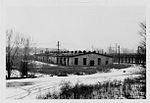Hmongtown Marketplace

Hmongtown Marketplace is an indoor market focused on Hmong American products and culture in the Frogtown neighborhood of Saint Paul, Minnesota. Hmongtown is noted for its cuisine and produce, with the Star Tribune calling the food court "one of the state's top culinary gems." It is variously referred to as the Hmong Farmers Market or Hmong Flea Market, or simply "Hmongtown" to emphasize its role as a cultural hub like a Chinatown, not just a retail location.More than 200 vendors sell traditional food, clothing, and home goods especially from Hmong and Hmong American culture, including from Cambodia, Vietnam, Laos and Thailand. It is designed to simulate open-air markets in Chiang Mai, Thailand, and Vientiane, Laos sells culturally specific fruits, vegetables, nuts, and other edible plants. Hot and ready-made food vendors sell a variety of dishes such as roast meats, boba tea, papaya salad, and bánh mì. Home goods include green market, electronics, religious supplies, and garden tools. In the summer the market nearly doubles in size with an outdoor market in the surrounding paved lot that brings the number of vendors up to 300 or more. The outdoor market is sometimes referred to as the Hmongtown Farmers Market and sells produce as well as meat, clothing and textiles, herbal medicine, live potted plants, and home products.The large size and foot traffic have led to the nickname "Hmong Mall of America". 600 people work inside, as many as 20,000 customers have been noted during events, and there is capacity for more than 300 stalls. The interior footpath complexity due to the many stalls has been described as "labyrinthine" and "byzantine". Because of the wide variety of products and services offered at Hmongtown, it is referred to as many different kinds of markets, such as a mall, a supermarket, a flea market, a farmers market, a marketplace, and a food hall.
Excerpt from the Wikipedia article Hmongtown Marketplace (License: CC BY-SA 3.0, Authors, Images).Hmongtown Marketplace
Como Avenue, Saint Paul Frogtown
Geographical coordinates (GPS) Address Nearby Places Show on map
Geographical coordinates (GPS)
| Latitude | Longitude |
|---|---|
| N 44.961388888889 ° | E -93.109444444444 ° |
Address
Como Avenue
55155 Saint Paul, Frogtown
Minnesota, United States
Open on Google Maps







